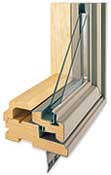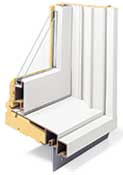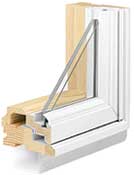Architects' Widening View of Windows: Technical Advances Elevate the Role of Fenestration
This new high-performance contribution of the window isn't a given, however, but must be integrated with the total building performance.
Climate, site, building orientation, glazing area, and location are considered extremely important. In other words, only a holistic approach to building design promotes energy efficiency. The fenestration design must also consider HVAC system type and efficiency, utility type and rates, internal loads, window area and orientation, and shading. Determining realistic building performance values requires use of valid performance values of window assemblies for modeling studies. The emphasis on performance-based design, as well as appropriate material and manufacturing processes, may ultimately promote the realities of sustainable architecture.
|
||||||
But back to window technology. To understand where we are, it's important to see where we've come from and how rapidly technology has progressed, particularly in the 20th century. It's also intriguing to try to sort out the chicken-and-egg question about social needs and technology - do our needs push technological development or does technology often precede our mass cultural yearnings? The glass and window industry offers some fascinating insights into social and cultural as well as architectural history.
Manufacturing Glass, First
Since the earth was formed, glass has been made naturally - by high-temperature conditions cooling and solidifying rapidly, like volcanic eruptions, lightning strikes, or the impact of meteorites. Stone-age man used cutting tools of natural glass called obsidian. Glass was first "discovered" by Phoenician merchants around 5000 B.C. While transporting stones of nitrate, the merchants rested cooking pots upon the stones, which eventually mixed with sand on the beach and formed an opaque liquid. The earliest man-made nontransparent glass fragments date back to the 16 century BC and were found in Mesopotamia. A major breakthrough in glassmaking was the discovery of glassblowing some time between 27 BC and AD 14, attributed to Syrian craftsmen.
The Ancient Romans were the first to use glass for architectural purposes, with the discovery of clear glass (through the introduction of manganese oxide) in Alexandria about AD 100. Although of poor quality, cast glass windows appeared in the most important buildings in Rome and the luxury villas of Herculaneum and Pompeii. With the decline of the Roman Empire, progress in the field of glassmaking techniques slowed, however, without any major improvements made until the Middle Ages.
In the 11th century, Germany produced the first glass sheets by a technique that was further developed in the 13th century by Venetian craftsmen.
By blowing a hollow glass sphere and swinging it vertically, gravity would pull the glass into a cylindrical "pod." While still hot, the ends of the pod were cut off and the resulting cylinder cut lengthways and laid flat. Panes of sheet glass, known as crown glass, would be joined with lead strips and pieced together to create windows. At that time glazing was a great luxury, mostly reserved for palaces and churches. Most buildings had small windows and dark and dank interiors. It was more typical for the openings to be shuttered and covered with oil and paper. Large-scale production of sheet glass - enough to bring the development of the manufactured windows industry - didn't occur until the mid 1700s, and even then only the wealthy could afford them.












